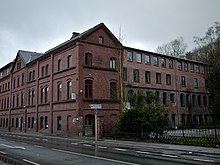Abel leather factory
The Abel leather factory is one of the last surviving leather factory buildings in Mülheim an der Ruhr and has been the location of the Leather and Tanner Museum since 2003 . Together with the last remaining active production facility - the Lindgens leather factory - it is part of the route of industrial culture .
The Abel leather factory was one of more than 50 factories that served the increased demand for leather articles during the industrialization phase of the Ruhr area. The product range included harnesses for tow horses , transmission belts for steam engines and protective clothing for work in mines and blast furnaces .
Carl Abel (1838–1904) laid the foundation stone with the establishment of a tannery not far from the Ruhr in what is now the Mülheim district of Broich in 1864. Gradually, the business was expanded, first with a factory owner's house (1885), then with a folding shop (1888) , Drying rooms, a boiler house and a chrome tannery (1905). With the death of the company founder Carl Abel in 1904, his sons Wilhelm, Walter and Carl August took over management of the company. In 1968 the production was stopped.
After the factory building was briefly threatened with demolition in 1990, it was listed as a historical monument in 1993. An investor acquired the company premises in 1998 and created a conversion concept. A hotel, a restaurant and the Mülheim Leather and Gerber Museum have shared the building since 2003.
literature
- Melanie Rimpel: Abel leather factory . In: Leather - Industry - Architecture, pp. 40–47. Mülheim an der Ruhr, 2004.
Web links
- Homepage of the leather and tanning museum
- Building description in the list of monuments of the city of Mülheim
- Description of all locations on this themed route as part of the Route of Industrial Culture
Coordinates: 51 ° 24 '57.3 " N , 6 ° 52' 4.8" E

